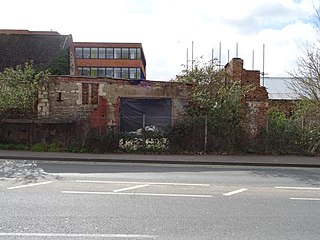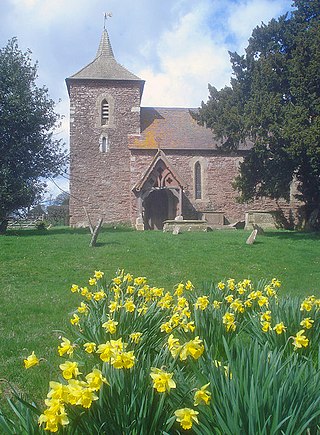Related Research Articles

Lower Catesby is a hamlet in the civil parish of Catesby, Northamptonshire, about 4 miles (6.4 km) southwest of Daventry. Lower Catesby is beside the nascent River Leam, which rises about 1 mile (1.6 km) to the south in the parish of Hellidon. The Jurassic Way long-distance footpath passes through Lower Catesby. The population of the hamlet is included in the civil parish of Hellidon.

Wenlock Priory, or St Milburga's Priory, is a ruined 12th-century monastery, located in Much Wenlock, Shropshire, at grid reference SJ625001. Roger de Montgomery re-founded the Priory as a Cluniac house between 1079 and 1082, on the site of an earlier 7th-century monastery. In 1101 bones, believed to be those of Saint Milburga, were discovered beneath the floor of the old church. The relics were ceremoniously translated to the main monastery church.

Weobley is an ancient settlement and civil parish in Herefordshire, England. Formerly a market town, the market is long defunct and the settlement is today promoted as one of the county's black and white villages owing to its abundance of old timber-framed buildings. Although it has the historical status of a town and is referred to as such in the sources, it nowadays refers to itself as a village.

Llanwarne is a village and civil parish in Herefordshire, England. The population of the civil Parish as taken at the 2011 census was 380. It is about 5 miles (8 km) from the Welsh border, is approximately 6 miles (10 km) north-west of Ross-on-Wye, and near Harewood End and Pencoyd.
Lingen is a village and civil parish, situated in the wooded hills of Herefordshire, England in the Welsh Marches, near to the border with Wales and close to the larger village of Wigmore. Situated in the north-west corner of the county, Lingen parish includes the hamlets of Deerfold, Limebrook, Birtley and Willey. It lies on the Limebrook which runs into the River Lugg south of the village. It lies at a height of between 145 and 283 metres above sea level.

The Parish and Priory Church of St Mary is located in Chepstow, Monmouthshire, south east Wales. Parts of the building, including its ornate west doorway, date from the late 11th century and are contemporary with the nearby Norman castle. The church is a Grade I listed building.
Stydd Hall (Castle) is a country house located near to the village of Yeaveley, Derbyshire, 15 miles (24 km) west of Derby, close to the A515 between Wyaston to the north, Great Cubley to the south, Yeaveley to the east and Alkmonton to the northeast. Stydd had formerly been an independent township but has all but disappeared: the hall and a farm are all that remains.

The Old House is a distinctive black and white half-timbered house in High Town, Hereford, England, built in 1621. It was restored in the 19th century and became a museum of Jacobean life in 1929.
Longworth Roman Catholic Chapel is a redundant chapel in the village of Bartestree, Herefordshire, England, standing adjacent to the former Convent of Our Lady of Charity and Refuge. It is recorded in the National Heritage List for England as a designated Grade II* listed building, and is owned by the Historic Chapels Trust.
Craswall Priory was a Grandmontine priory in Herefordshire, England at grid reference SO27253770 dating from 1220 to 1225. The poor condition of the ruins mean that they are on Historic England's Heritage at Risk Register.

Maxstoke Priory was an Augustinian priory in Warwickshire, England. The substantial remains are on Historic England's Heritage at Risk Register due to their poor condition.
Pinley Priory, also called Pinley Abbey, was a Cistercian nunnery in the parish of Rowington in Warwickshire, England. It was founded in the early 12th century and dissolved in 1536.

Yatton Chapel is a redundant Anglican church in Yatton, south-east Herefordshire, England. It is recorded in the National Heritage List for England as a designated Grade II* listed building, and is under the care of the Churches Conservation Trust. It stands at the end of a winding track adjacent to Chapel Farmhouse.

The Church of St Paul in Stamford, Lincolnshire, England, was one of the town's fourteen Medieval parish churches until its deconsecration and extensive demolition during the Reformation when the remaining part became used as the schoolroom of Stamford School. It was then restored and extended in 1929-30 for use as the school chapel in commemoration of those old boys and staff who had died in the First World War. The medieval remains were the eastern part of the south aisle and adjacent fragments of the nave of the church.

Stoneywell is a National Trust property in Ulverscroft, a dispersed settlement near Coalville in Charnwood Forest, Leicestershire. Stoneywell is the largest of a small group of cottages designed in the Arts and Crafts style by Ernest Gimson. It was built in collaboration with Detmar Blow in 1899 for Ernest's brother Sydney Gimson as a summer residence, and along with much original furniture, it remained in the Gimson family for over a century. As part of a highly influential vernacular movement, it has become well known within Arts and Crafts circles. In spring 2013 the National Trust announced that following a year-long appeal, it had been able to acquire the house with its Arts and Crafts contents, gardens and woodland. It was opened to the public in February 2015.

Tanners Hall was a 13th century town house and is now a ruin located on Gouda Way in Gloucester. It is the oldest non-religious building and only surviving medieval domestic stone house in the city. It became a Grade II listed building on 29 July 2015.

Grendon Bishop is a civil parish in the county of Herefordshire, England.

Pencombe with Grendon Warren is a civil parish in the county of Herefordshire, England. The parish was created in 1895 from the parishes of Pencombe and Grendon Warren, its only nucleated settlement being the village of Pencombe.

Hatfield and Newhampton is a civil parish in the county of Herefordshire, England, and is 11 miles (18 km) north from the city and county town of Hereford. The closest large town is Leominster 4 miles (6 km) to the west. The parish includes the small village of Hatfield, the former extra-parochial liberty of New Hampton, the site of former abbey lands of Fencote, the preserved Fencote railway station, and the Grade II* listed 11th-century Church of St Leonard.
References
- 1 2 "Limebrook Priory". Herefordshire Through Time. Herefordshire Council. Archived from the original on 9 June 2011. Retrieved 25 September 2010.
- ↑ "Heritage Explorer: Limebrook Priory, Lingen, Herefordshire". Historic England.
- ↑ "Pastscape: Limebrook Priory". Historic England.
52°17′19″N2°55′06″W / 52.2885°N 2.9182°W

